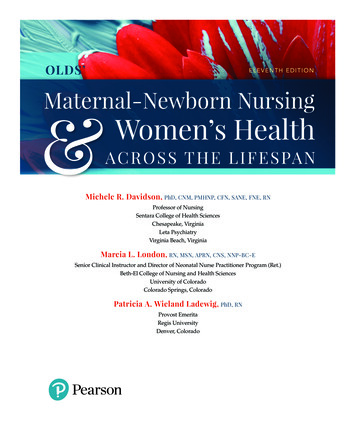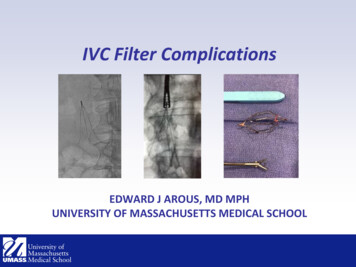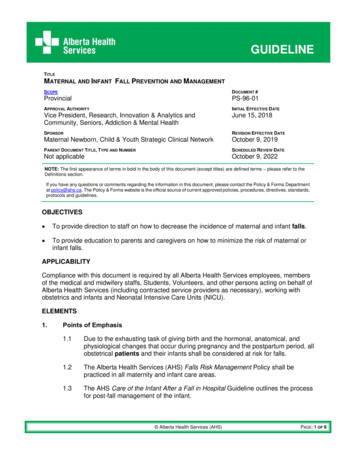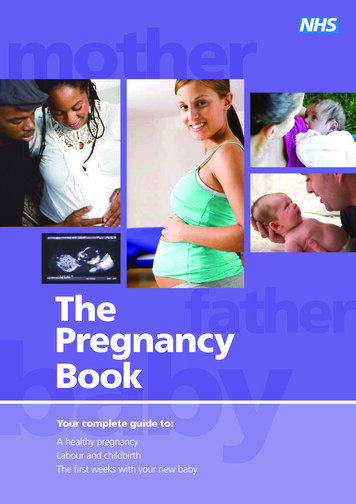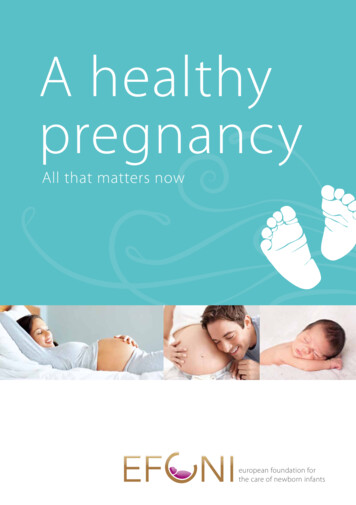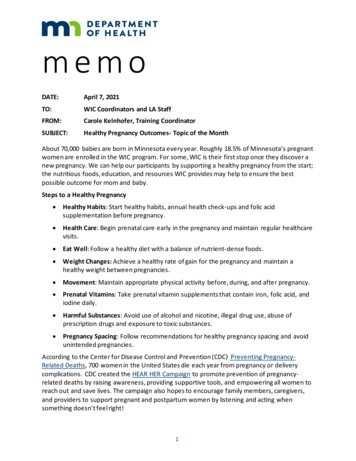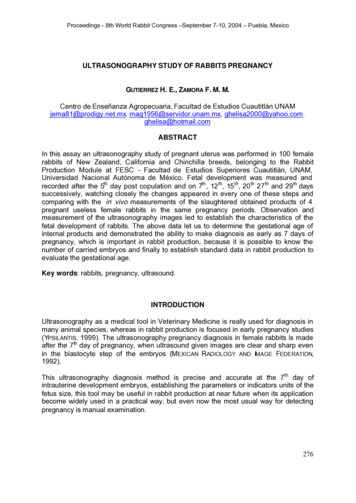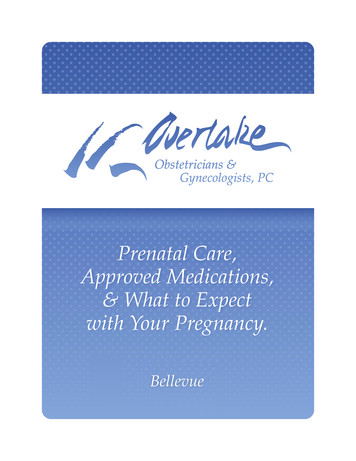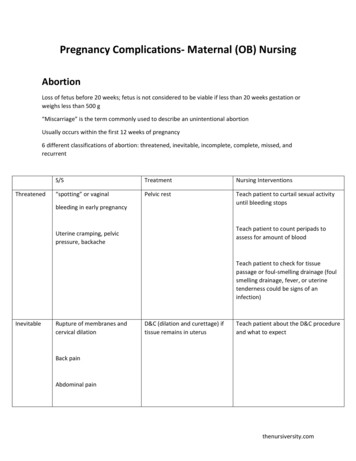
Transcription
Pregnancy Complications- Maternal (OB) NursingAbortionLoss of fetus before 20 weeks; fetus is not considered to be viable if less than 20 weeks gestation orweighs less than 500 g“Miscarriage” is the term commonly used to describe an unintentional abortionUsually occurs within the first 12 weeks of pregnancy6 different classifications of abortion: threatened, inevitable, incomplete, complete, missed, andrecurrentThreatenedS/STreatmentNursing Interventions“spotting” or vaginalPelvic restTeach patient to curtail sexual activityuntil bleeding stopsbleeding in early pregnancyTeach patient to count peripads toassess for amount of bloodUterine cramping, pelvicpressure, backacheTeach patient to check for tissuepassage or foul-smelling drainage (foulsmelling drainage, fever, or uterinetenderness could be signs of aninfection)InevitableRupture of membranes andcervical dilationD&C (dilation and curettage) iftissue remains in uterusTeach patient about the D&C procedureand what to expectBack painAbdominal painthenursiversity.com
IncompleteNot all uterine components andfetus are expelledSevere abdominal crampingand bleedingIV fluid replacementEnsure cardiovascular stability- patientis at high risk of hemorrhage.D&C or D&E (dilation andevacuation)IV Pitocin or IM Methergine tocontract the uterus afterprocedureCompleteAll components of pregnancyare expelledPelvic restMonitor for bleeding, pain, and feverTeach patient to avoid sexualintercourse until follow-up appointmentTeach patient is advisable to wait atleast 3 months before attempting toconceive againMissedFetus dies but is retained in theuterusD&CMonitor for signs of infection or DICIf infection is suspected-initiateantibiotic therapy before D&CIf disseminated intravascularcoagulation (DIC) is developing,then the priority is to deliver theplacenta and fetusRecurrent3 or more consecutivespontaneous abortionsAssist in completing a full reproductiveassessmentTeach patients about genetic counselingthenursiversity.com
If a woman is Rh-negative, RhoGam is given within 72 hours of abortionEctopic pregnancyImplantation of the fertilized ovum in ANY site other than the endometrial lining of the uterus.Most occur in the fallopian tube.Common causes: Pelvic inflammatory disease (PID) Intrauterine device for contraception Defects in fallopian tubes Cigarette smoking Vaginal douchingEarly manifestations Missed menstruation followed by vaginal bleeding- scant to profuse Unilateral pelvic pain; sharp abdominal pain Referred shoulder pain Cul-de-sac mass Beta hCG leels are lower than expected for gestationAcute manifestations (ruptured fallopian tube) Cullen’s sign- bluish discoloration around umbilicus N/V Faintness Hypovolemic shock can occur due to blood lossTreatment Combat shock/stabilize cardiovascular system Administer blood replacement IV fluid replacementLinear salpingectomy- for unruptured fallopian tube; removes fertilized egg and leaves the tubeopen to heal naturallythenursiversity.com
Methotrexate- folic acid antagonist that inhibits cell division in the embryo; used prior torupture Salpingectomy- surgically remove ruptured fallopian tube (reassure women that they can stillhave successful pregnancies in the future)Nursing interventions Prevent/ identify and treat hypovolemic shock Explain that nausea and vomiting may be experienced with methotrexate Teach patient to avoid alcohol and vitamins with folic acid while taking methotrexate Teach patient to avoid sexual intercourse until hCG levels are undetectableGestational Trophoblastic Disease- Hydatidiform MoleTrophoblast cells in the uterus develop abnormally. The placenta, but not the fetus, developsGrapelike vesicles that can grow large enough to fill the whole uterusChoriocarcinoma may spread rapidly to vagina, lung, liver, kidney, and brainSigns/symptoms: Vaginal bleeding- dark brown spotting to profuse hemorrhage Larger uterus than expected Excess N/V Early development of preeclampsia Diagnosed by ultrasound and levels of hCG (higher than expected)Treatment: D&C and vacuum aspiration of uterine contents (mole) Before evacuation Chest imaging CMP Baseline hCGAfter evacuation Curettage IV oxytocin to contract the uterusthenursiversity.com
Follow-up is extensive for the following year: Assess for the development of choriocarcinoma Beta hCG levels Q 1-2 weeks until 3 consecutive pre-pregnancy levels; then repeated Q 1-2months for up to a year Chest x-rays Placed on oral contraception to prevent a rise in hCG If choriocarcinoma develops, then chemotherapy is startedPlacenta previaPlacenta implants in the lower uterusClassified as marginal, partial, or completeMarginal (low lying)- lower border is more than 3 cm from cervical osPartial- placenta is within 3 cm of the cervical os but does not completely cover itTotal- placenta covers the cervical os completelySigns/symptoms: Sudden onset of painless uterine bleeding in later half of pregnancy Verified by ultrasound Copious amounts of bleeding during early laborManagement will vary based on maternal and fetal status Some women will be managed in the outpatient setting if they have no active bleeding and bedrest can be maintained at the home with the help of family Some women will need to be managed in the inpatient setting C-section delivery for ALL types except low lying due to the risk of bleeding and hemorrhage. Unless it is an emergency c-section due to fetal compromise or excessive bleeding in mother,most c-sections can be scheduled when the fetus is greater than 36 weeks gestation andhas mature lungsNursing interventions Avoid manual vaginal examinations or contraction stimulation Teach patient to assess vaginal discharge at every urination and defecation Teach patient to count fetal movements dailythenursiversity.com
Encourage bed rest Assess uterine activity daily Teach patient to omit sexual intercourse Nonstress test weekly 20 minute strip FHR needs to accelerate Ice cold water is the best method to wake the babyAbruptio PlacentaPlacental abruption- separation of placenta before deliveryRisk factors include maternal HTN, short umbilical cord, trauma, smoking, caffeine, cocaine, vascularproblems (DM), multigravida statusFetal vessels are disrupted so fetal bleeding occurs as wellMajor danger is hemorrhage and hypovolemic shockSigns/symptoms:5 classic s/s Profuse vaginal bleeding Abdominal/low back pain- aching/dull Uterine irritability- quivers on strip; frequent low-intensity contractions High resting tone- uterus never gets soft Uterine tendernessNursing interventions Prepare patient for C-section immediately Combat shock- blood replacement/fluid replacement Continue monitoring mom and baby as excessive bleeding and fetal hypoxia are major concerns Assess for complications of DIC- check PT, PTT, fibrinogen, CBCthenursiversity.com
Placenta previa vs abruption placenta in a nutshell:Placenta previaAbruptio PlacentaPAINLESS vaginal bleedingBleeding accompanied by painBright red bleedingDark red bleedingFirst episode of bleeding is slight then becomesprofuseFirst episode of bleeding is usually profuseSigns of blood loss compatible to extent ofbleedingSigns of blood loss out of proportion to visibleamountUterus soft, non-tenderUterus board-like, painful; low back painFetal parts palpable; FHR countable and uterus isnot hypertonicFetal parts non-palpable; FHR non-countable andhigh uterine resting toneBlood clotting defect absentBlood clotting defect (DIC) likelyDIC- Disseminated Intravascular CoagulationAnticoagulation and procoagulation factors are activated simultaneouslyRisk factors include abruption, PIH/HELLP syndrome (impaired liver function impairs clotting), sepsis,anaphylactoid syndromeSigns/symptoms: Bleeding Clots Bruising everywhere Significant drop in blood pressure CBC: platelets less than 100,000, increased fibrin degradation products, prolonged PTT and PT,decreased serum fibrinogenNursing interventions: Assist with delivery of fetus and placenta which is fueling the DIC process Administer fluid replacement- IV fluid, blood, and blood productsHyperemisis GravidarumSevere uncontrollable vomiting that begins in the first weeks of pregnancy.Exact causes are unknownthenursiversity.com
Signs/symptoms: Persistent nausea and vomiting Weight loss of 5% or more of body weight May become severely dehydrated Depletion of essential electrolytes- low sodium, potassium, and chloride Increased hgb and hct- hemoconcentrationNursing interventions: Reduce severity of nausea and vomiting Teach patient that food portions should be small Teach patient to eliminate foods with strong odors Teach patient that the best foods to eat are lowfat foods and easy to digest carbs such as fruit,bread, cereals, and rice Teach patient to sit up right after meals Teach patient to drink liquids and soups in between meals as to avoid overdistention of thestomach Maintain nutrition and fluid balance Teach patient to eat every 2-3 hours; salt food to replace chloride Administer IV fluids and TPN if orderedProvide emotional support Encourage and allow expression of feelingsHypertensive DisordersFour categories of hypertensive disorders- gestational hypertension, preeclampsia, eclampsia, chronichypertensionthenursiversity.com
Gestational HypertensionPreeclampsiaEclampsiaChronic HypertensionElevated BP after 20 140/90 mm HG after 20Progression ofHypertension was presentweeks gestationweekspreeclampsiabefore pregnancy and isNot accompanied byAccompanied byAccompanied by seizuresnot related to pregnancyproteinuriaproteinuriaThe blood pressure rises due to arteriolar vasospasms and vasoconstriction causing: An increase in peripheral resistance Fluid forced out of the vessels HemoconcentrationSigns/symptoms: High blood pressure Proteinuria as a result of glomerular damage Increased BUN, creatinine, and uric acid due to decreased renal perfusion Weight gain related to fluid retention Generalized edema Headaches and blurred vision due to cerebral vessel vasoconstriction Epigastric pain due to hepatic edema and increased liver enzymes (may have an impendingseizure due to the distention and closing off of the liver capsule) Hyperreflexia- brisk DTRs Clonus Vascular constriction and narrowing of small arteries in the retinaThe nurse must know the difference between dependent edema and generalized edema. The patientwith pregnancy induced hypertension has generalized edema because fluid is in all tissuesPre-eclampsia 140/90 mm Hg after 20 weeks gestation accompanied by significant proteinuria (greater than0.3 g)thenursiversity.com
Associated with intrauterine growth restriction (IUGR)MildSevere140/90 mm Hg160/90 mm HgProtein 1 to 2 Protein 3 to 4 Edema 1 to lower legsEdema 3 to 4 generalized1-pound gain in a weekGreater than 2-pound gain in a weekReflexes 1 to 2 Reflexes 3 to 4 Visual disturbances absent or minimalVisual disturbances commonPlacenta grading will exceed the normal value (placenta is aging faster than it should)- the nurse willnote decelerations in the case of an abnormally old placentaHome Management of Preeclampsia:Woman may be allowed to stay at home if she and the fetus are in stable condition and the woman canadhere to the treatment plan.The treatment plan includes: Activity restriction- full bedrest is not required- side-lying position to maximize placental bloodflow when resting Monitor fetal activity- record “kick counts”; should have a minimum of 3 movements in onehour. If no fetal movement is detected in a 4-hour period, physician should be notified Check blood pressure 2-4 times per day Weigh daily- preferably in the morning Dipstick test every morning with first void Diet- 70-80 g protein, low salt, no caffeine, no smokingInpatient Nursing CareWomen with severe preeclampsia will be monitored in the inpatient facility Complete bed rest; quiet environment to prevent overstimulation Anticonvulsant medicationsthenursiversity.com
Magnesium sulfateMagnesium Sulfate Relaxes smooth muscle and reduces vasoconstriction CNS depressant Therapeutic serum magnesium level: 4-8 mg/dL Loading dose is typically 4-6 g and the maintenance dose is titrated and is often 2g/hourNursing interventions for Mag Infusion: Monitor vital signs closely during IV infusion At risk for respiratory depression. If respirations are less than 12, then the HCP shouldbe notified- stop infusion of mag, administer calcium gluconateAssess reflexes Infusion will need to be altered or stopped if DTRs are absent or hyper Assess for clonus- should be absent Measure urinary output. Should be 30 mL/hour or the patient will be at risk of excessive serummagnesium levels Urine dipstick for protein Measure magnesium level every 6 hours Monitor for signs of magnesium toxicity Less than 14 breaths per minute 02 sat less than 95% Absence of DTRs Sweating, flushing Confusion, lethargy, disorientation HypotensionCalcium gluconate is the antidote Keep at bedside and push 1 mL/min VS every hourAntihypertensive Medications Hydrazaline (Apresoline)- vasodilator- increases cardiac output and placental blood flowthenursiversity.com
Nifedipine- calcium channel blocker Labetalol- beta-adrenergic blocker- can affect the infant so it is rarely usedEclampsiaPreeclampsia manifestations plus generalized seizuresGeneralized seizures start with facial twitching, followed by rigidity of the bodyResults in fetal bradycardia, loss of variability, or late decelerationsNursing interventions: Fetal monitoring to assess for signs of fetal compromise Place patient in left side-lying position to decrease risk of aspiration and increase maternal andfetal blood flow Monitor for contractions Pad side rails to reduce injury if a seizure occurs Administer magnesium as ordered Administer furosemide as ordered in case of pulmonary edema Frequent maternal assessment- lung sounds hourly, hourly urine output, ruptured membranes,signs of labor, or abruptio placentae Apply oxygen via face mask at 8-10 L/min as needed Prepare pa
Early development of preeclampsia . Inpatient Nursing Care Women with severe preeclampsia will be monitored in the inpatient facility Complete bed rest; quiet environment to prevent overstimulation Anticonvulsant medications . thenursiversity.com Magnesium sulfate Magnesium Sulfate Relaxes smooth muscle and reduces vasoconstriction CNS depressant Therapeutic serum magnesium level: 4-8

